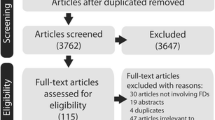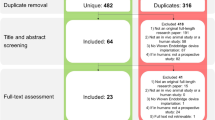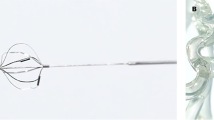Abstract
Introduction
Flow diversion (FD) is increasingly used to treat intracranial aneurysms. We sought to systematically review published studies to assess the quality of reporting and summarize the results of FD in various animal models.
Methods
Databases were searched to retrieve all animal studies on FD from 2000 to 2015. Extracted data included species and aneurysm models, aneurysm and neck dimensions, type of flow diverter, occlusion rates, and complications. Articles were evaluated using a checklist derived from the Animal Research: Reporting of In Vivo Experiments (ARRIVE) guidelines.
Results
Forty-two articles reporting the results of FD in nine different aneurysm models were included. The rabbit elastase-induced aneurysm model was the most commonly used, with 3-month occlusion rates of 73.5 %, (95 %CI [61.9–82.6 %]). FD of surgical sidewall aneurysms, constructed in rabbits or canines, resulted in high occlusion rates (100 % [65.5–100 %]). FD resulted in modest occlusion rates (15.4 % [8.9–25.1 %]) when tested in six complex canine aneurysm models designed to reproduce more difficult clinical contexts (large necks, bifurcation, or fusiform aneurysms). Adverse events, including branch occlusion, were rarely reported. There were no hemorrhagic complications. Articles complied with 20.8 ± 3.9 of 41 ARRIVE items; only a small number used randomization (3/42 articles [7.1 %]) or a control group (13/42 articles [30.9 %]).
Conclusion
Preclinical studies on FD have shown various results. Occlusion of elastase-induced aneurysms was common after FD. The model is not challenging but standardized in many laboratories. Failures of FD can be reproduced in less standardized but more challenging surgical canine constructions. The quality of reporting could be improved.



Similar content being viewed by others
References
Turjman F, Acevedo G, Moll T, Duquesnel J, Eloy R, Sindou M (1993) Treatment of experimental carotid aneurysms by endoprosthesis implantation: preliminary report. Neurol Res 15:181–184
Geremia G, Haklin M, Brennecke L (1994) Embolization of experimentally created aneurysms with intravascular stent devices. AJNR Am J Neuroradiol 15:1223–1231
Byrne JV, Beltechi R, Yarnold JA, Birks J, Kamran M (2010) Early experience in the treatment of intra-cranial aneurysms by endovascular flow diversion: a multicentre prospective study. PLoS One 5:e12492. doi:10.1371/journal.pone.0012492
U.S. Food and Drug Administration. Pipeline™ Embolization Device-P100018. USA: 2011/04/06; http://www.hc-sc.gc.ca/dhp-mps/prodpharma/sbd-smd/md-im/sbd_smd_2010_pipeline_embolization_148227-eng.php. http://www.fda.gov/MedicalDevices/ProductsandMedicalProcedures/DeviceApprovalsandClearances/Recently-ApprovedDevices/ucm252130.htm
Kulcsar Z, Houdart E, Bonafe A, Parker G, Millar J, Goddard AJ, Renowden S, Gál G, Turowski B, Mitchell K, Gray F, Rodriguez M, van den Berg R, Gruber A, Desal H, Wanke I, Rüfenacht DA (2011) Intra-aneurysmal thrombosis as a possible cause of delayed aneurysm rupture after flow-diversion treatment. AJNR Am J Neuroradiol 32:20–25. doi:10.3174/ajnr.A2370
Kulcsar Z, Ernemann U, Wetzel SG, Bock A, Goericke S, Panagiotopoulos V, Forsting M, Ruefenacht DA, Wanke I (2010) High-profile flow diverter (SILK) implantation in the basilar artery: efficacy in the treatment of aneurysms and the role of the perforators. Stroke 41:1690–1696. doi:10.1161/STROKEAHA.110.580308
Turowski B, Macht S, Kulcsar Z, Hänggi D, Stummer W (2011) Early fatal hemorrhage after endovascular cerebral aneurysm treatment with a flow diverter (SILK-Stent): do we need to rethink our concepts? Neuroradiology 53:37–41. doi:10.1007/s00234-010-0676-7
Darsaut TE, Gentric JC, McDougall CM, Gevry G, Roy D, Weill A, Raymond J (2015) Uncertainty and agreement regarding the role of flow diversion in the management of difficult aneurysms. AJNR Am J Neuroradiol 36:930–936. doi:10.3174/ajnr.A4201
Kilkenny C, Browne WJ, Cuthill IC, Emerson M, Altman DG (2010) Improving bioscience research reporting: the ARRIVE guidelines for reporting animal research. PLoS Biol 8:e1000412. doi:10.1371/journal.pbio.1000412
Higgins J, Green S Cochrane handbook for systematic reviews of interventions. Version 5.1.0. (updated March 2011) http://handbook.cochrane.org/
Stroup DF, Berlin JA, Morton SC, Olkin I, Williamson GD, Rennie D, Moher D, Becker BJ, Sipe TA, Thacker SB (2000) Meta-analysis of observational studies in epidemiology: a proposal for reporting. Meta-analysis of observational studies in epidemiology (MOOSE) group. JAMA 283:2008–2012
Moher D, Liberati A, Tetzlaff J, Altman DG, PRISMA Group (2009) Preferred reporting items for systematic reviews and meta-analyses: the PRISMA statement. PLoS Med 6:e1000097. doi:10.1371/journal.pmed.1000097
Kamran M, Yarnold J, Grunwald IQ, Byrne JV (2011) Assessment of angiographic outcomes after flow diversion treatment of intracranial aneurysms: a new grading schema. Neuroradiology 53:501–508. doi:10.1007/s00234-010-0767-5
Cumberland Consensus Working Group, Cheeran B, Cohen L, Dobkin B, Ford G, Greenwood R, Howard D, Husain M, Macleod M, Nudo R, Rothwell J, Rudd A, Teo J, Ward N, Wolf S (2009) The future of restorative neurosciences in stroke: driving the translational research pipeline from basic science to rehabilitation of people after stroke. Neurorehabil Neural Repair 23:97–107. doi:10.1177/1545968308326636
Kaste M (2005) Use of animal models has not contributed to development of acute stroke therapies: pro. Stroke 36:2323–2324
Pound P, Ebrahim S, Sandercock P, Bracken MB, Roberts I, Reviewing Animal Trials Systematically (RATS) Group (2004) Where is the evidence that animal research benefits humans? BMJ 328:514–517
Kilkenny C, Parsons N, Kadyszewski E, Festing MF, Cuthill IC, Fry D, Hutton J, Altman DG (2009) Survey of the quality of experimental design, statistical analysis and reporting of research using animals. PLoS One 4:e7824. doi:10.1371/journal.pone.0007824
Vesterinen HM, Sena ES, ffrench-Constant C, Williams A, Chandran S, Macleod MR (2010) Improving the translational hit of experimental treatments in multiple sclerosis. Mult Scler 16:1044–1055. doi:10.1177/1352458510379612
Ting KH, Hill CL, Whittle SL (2015) Quality of reporting of interventional animal studies in rheumatology: a systematic review using the ARRIVE guidelines. Int J Rheum Dis 18:488–494. doi:10.1111/1756-185X.12699
Landis SC, Amara SG, Asadullah K, Austin CP, Blumenstein R, Bradley EW, Crystal RG, Darnell RB, Ferrante RJ, Fillit H, Finkelstein R, Fisher M, Gendelman HE, Golub RM, Goudreau JL, Gross RA, Gubitz AK, Hesterlee SE, Howells DW, Huguenard J, Kelner K, Koroshetz W, Krainc D, Lazic SE, Levine MS, Macleod MR, McCall JM, Moxley RT 3rd, Narasimhan K, Noble LJ, Perrin S, Porter JD, Steward O, Unger E, Utz U, Silberberg SD (2012) A call for transparent reporting to optimize the predictive value of preclinical research. Nature 490:187–191. doi:10.1038/nature11556
National Research Council Institute for Laboratory Animal Research (2011) Guidance for the description of animal research in scientific publications. Washington (District of Columbia). National Academies Press. Available online http://www.nap.edu/openbook.php?record_id=13241
Sena ES, van der Worp HB, Bath PM et al (2010) Publication bias in reports of animal stroke studies leads to major overstatement of efficacy. PLoS Biol 8:e1000344. doi:10.1371/journal.pbio.1000344
Sena ES, van der Worp HB, Bath PM, Howells DW, Macleod MR (2010) Factors affecting the apparent efficacy and safety of tissue plasminogen activator in thrombotic occlusion models of stroke: systematic review and meta-analysis. J Cereb Blood Flow Metab 30:1905–1913. doi:10.1371/journal.pbio.1000344
Kallmes DF, Helm GA, Hudson SB, Altes TA, Do HM, Mandell JW, Cloft HJ (1999) Histologic evaluation of platinum coil embolization in an aneurysm model in rabbits. Radiology 213:217–222
Ding YH, Dai D, Lewis DA, Cloft HJ, Kallmes DF (2005) Angiographic and histologic analysis of experimental aneurysms embolized with platinum coils, Matrix, and HydroCoil. AJNR Am J Neuroradiol 26:1757–1763
Hans FJ, Krings T, Moller-Hartmann W, Thiex R, Pfeffer J, Scherer K, Brunn A, Dreeskamp H, Stein KP, Meetz A, Gilsbach JM, Thron A (2003) Endovascular treatment of experimentally induced aneurysms in rabbits using stents: a feasibility study. Neuroradiology 45:430–434
Krings T, Hans FJ, Moller-Hartmann W, Brunn A, Thiex R, Schmitz-Rode T, Verken P, Scherer K, Dreeskamp H, Stein KP, Gilsbach J, Thron A (2005) Treatment of experimentally induced aneurysms with stents. Neurosurgery 56:1347–1359, discussion 1360
Brinjikji W, Murad MH, Lanzino G, Cloft HJ, Kallmes DF (2013) Endovascular treatment of intracranial aneurysms with flow diverters: a meta-analysis. Stroke 44:442–447. doi:10.1161/STROKEAHA.112.678151
Cruz JP, Chow M, O’Kelly C, Marotta B, Spears J, Montanera W, Fiorella D, Marotta T (2012) Delayed ipsilateral parenchymal hemorrhage following flow diversion for the treatment of anterior circulation aneurysms. AJNR Am J Neuroradiol 33:603–608. doi:10.3174/ajnr.A3065
Raymond J, Darsaut TE, Kotowski M, Makoyeva A, Gevry G, Berthelet F, Salazkin I (2013) Thrombosis heralding aneurysmal rupture: an exploration of potential mechanisms in a novel giant swine aneurysm model. AJNR Am J Neuroradiol 34:346–353. doi:10.3174/ajnr.A3407
Siddiqui AH, Abla AA, Kan P, Dumont TM, Jahshan S, Britz GW, Hopkins LN, Levy EI (2012) Panacea or problem: flow diverters in the treatment of symptomatic large or giant fusiform vertebrobasilar aneurysms. J Neurosurg 116:1258–1266. doi:10.3171/2012.2.JNS111942
Juni P, Holenstein F, Sterne J, Bartlett C, Egger M (2002) Direction and impact of language bias in meta-analyses of controlled trials: empirical study. Int J Epidemiol 31:115–123
Acknowledgments
RF receives a research scholarship from the Fondation pour la Recherche Médicale (FRM), Paris, FRANCE (grant number DEA20140630151). Tim Darsaut received a research grant from the Heart and Stroke Foundation of Alberta (grant # GIA-0200296).
Author information
Authors and Affiliations
Corresponding author
Ethics declarations
We declare that this manuscript does not contain clinical studies or patient data
Conflict of interest
We declare that we have no conflict of interest.
Rights and permissions
About this article
Cite this article
Fahed, R., Raymond, J., Ducroux, C. et al. Testing flow diversion in animal models: a systematic review. Neuroradiology 58, 375–382 (2016). https://doi.org/10.1007/s00234-015-1635-0
Received:
Accepted:
Published:
Issue Date:
DOI: https://doi.org/10.1007/s00234-015-1635-0




